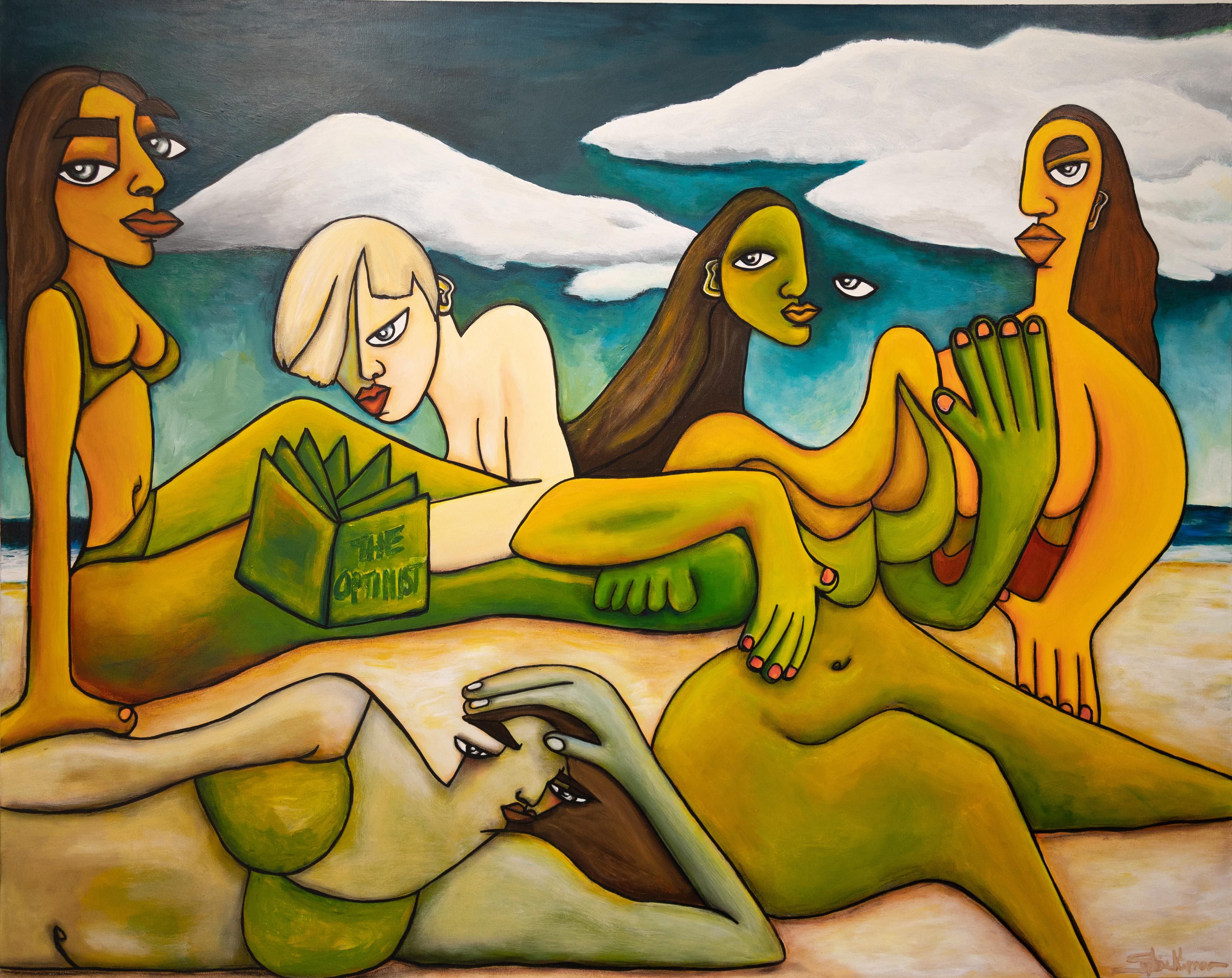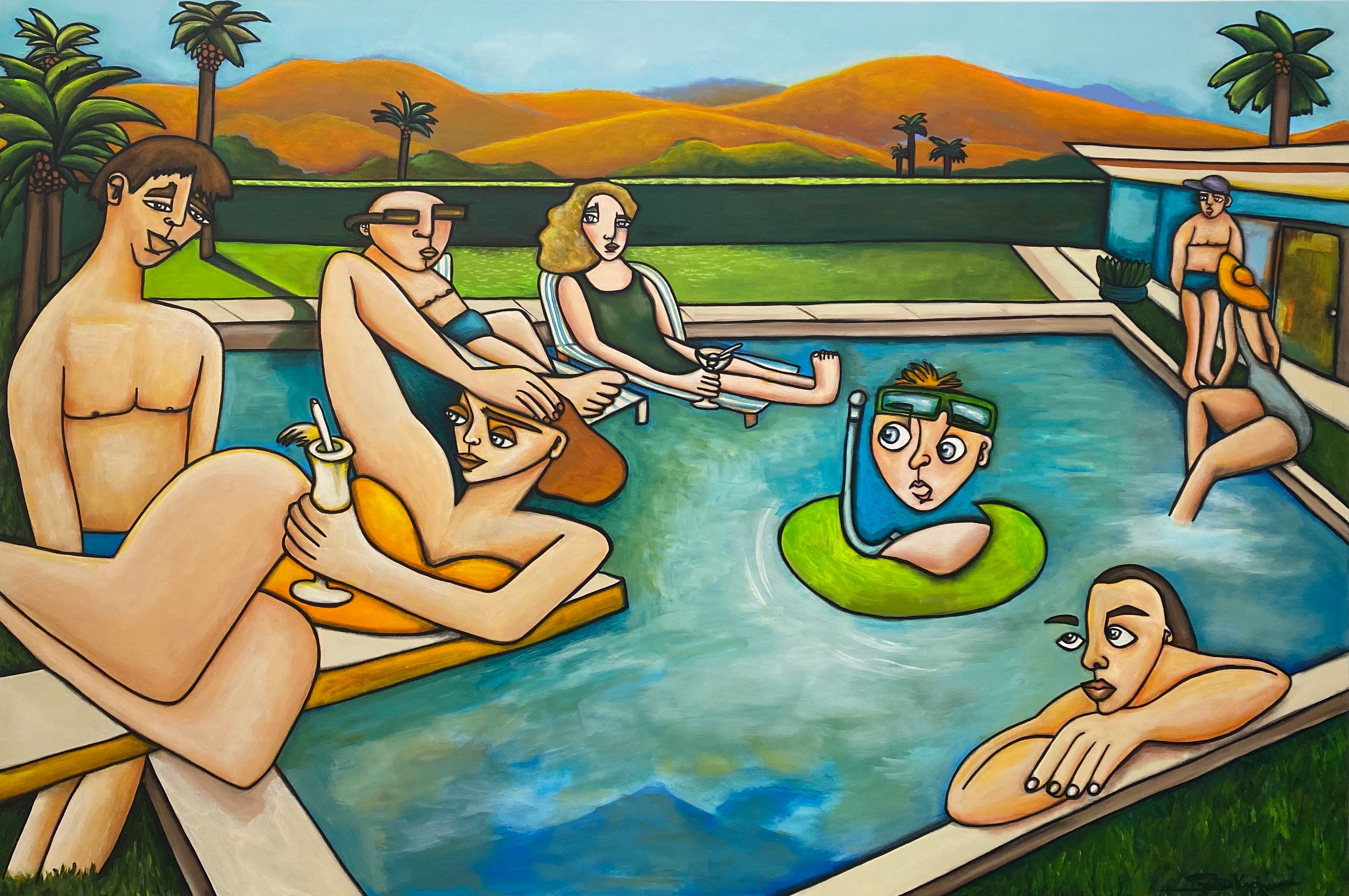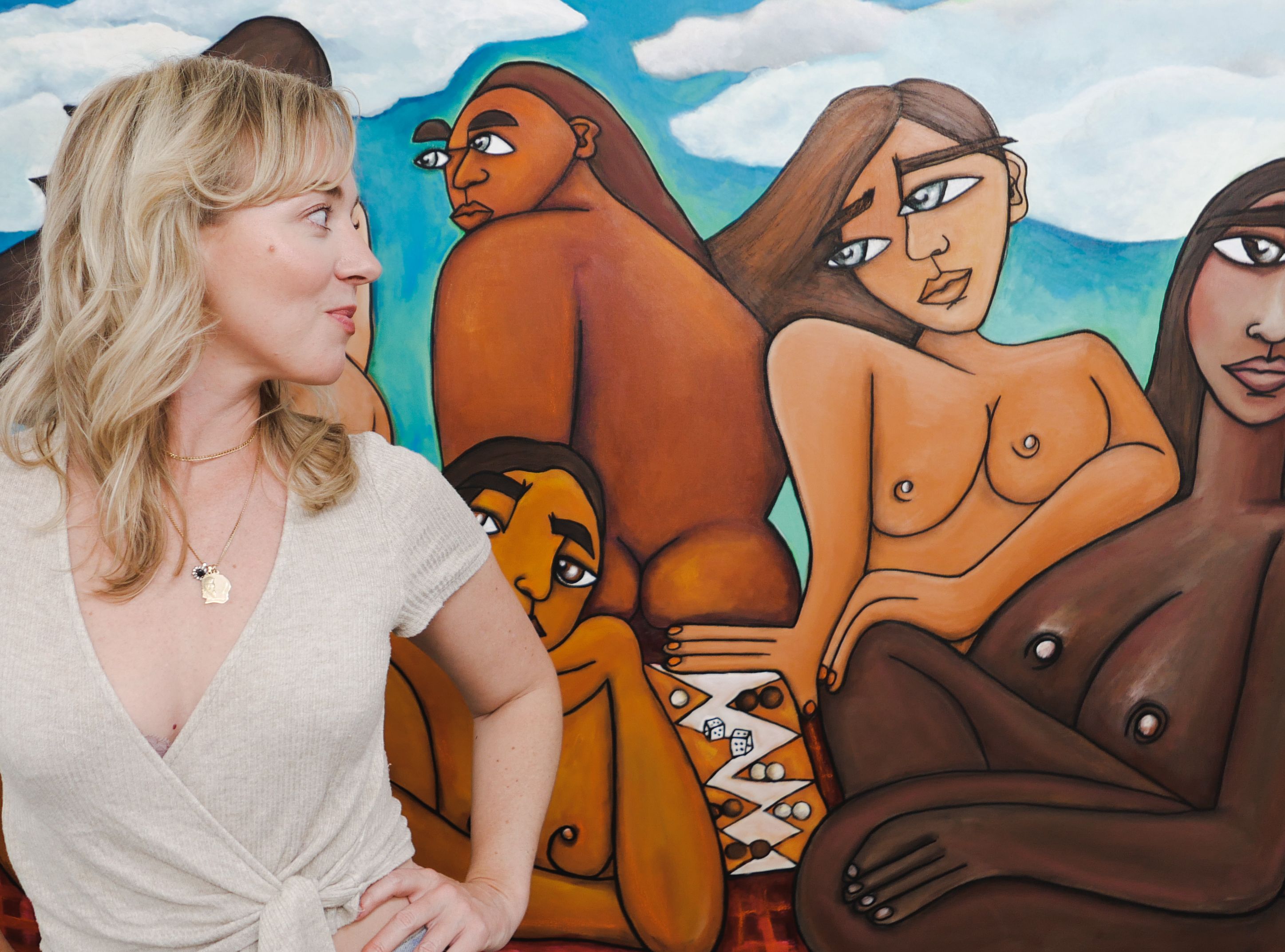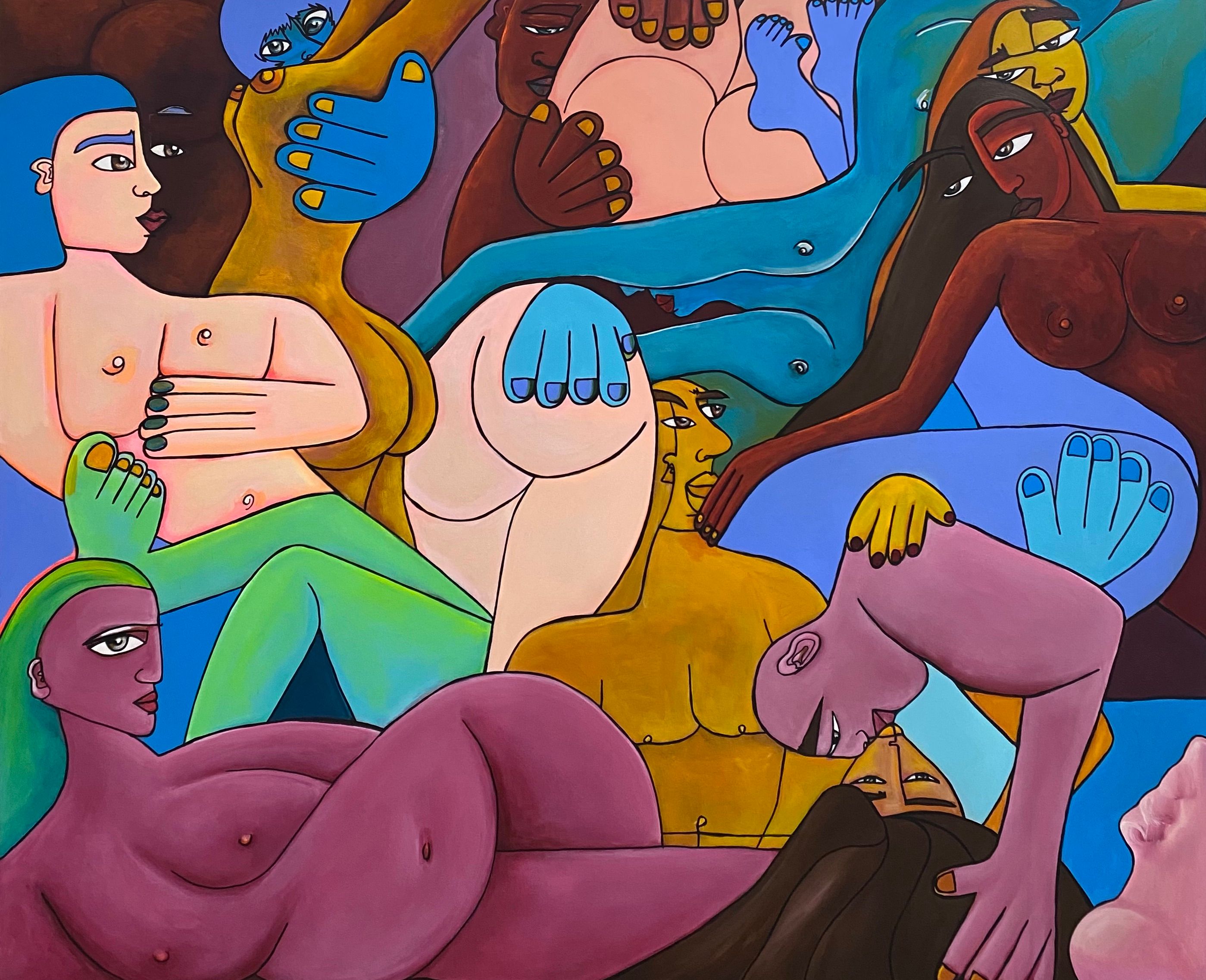
The artist and writer Sophie Kipner hails from Topanga, California and her unique approach to portraiture utilises a technique known as blind contouring, which primarily involves not lifting a pen or looking at the canvas when depicting her subjects (many of whom are increasingly drawn from some of the more infamous inhabitants of the Hollywood Hills). And while she is already the subject of a documentary produced by Courteney Cox, Alexandria Jackson and Joanna Natasegara entitled Sophie And The Baron, which chronicles her artistic collaboration with the late Rolling Stone Magazine photographer Baron Wolman (recently acquired by Disney+ as their first original documentary), she is also a published author, with her first book The Optimist receiving considerable praise. Most recently, her large scale paintings have taken a turn into surreal new vistas, in group scenes that often involve voluptuous naked bodies enveloping each other in sumptuous embraces that celebrate the human form. In this interview with Culture Collective, the artist explains why the isolation of the pandemic inspired her to create postcards of her fantasies, and tells us why every mode of expression is equally important in the pursuit of joy.
Talk to me about your approach to painting, you are known for the technique of blind contouring your subjects ...
As you know, I have been doing portraits of people with blind contouring for a long time, and I still feel that a lot of the time with my contouring, I pick up on way more emotion than I usually would. And I have stuck with this technique for so long because it is always inspiring for me. I can never know how it’s really going to come out, and I have to play with the technique until it feels right. I am still using blind contouring as an approach to the canvas, but it’s not like a rule that I have to keep to – it just helps me to create a more organic composition, and get the feeling that I want in the work. I then build on that contouring in a way that feels more evolved than it did in the early days. I think blind contouring helps you really experience a person, and my more recent paintings had me thinking about that thing of, well, if I painted myself, what would I see? And I wanted to add that element in the work, but not overtly. I would blind contour myself into a scene in such an abstract way that you can’t tell it's me, but I would have to do it until there was something in there that I recognised in myself, personally – even if that was a look in the eyes.

Your most recent works are something of a departure from the portraiture you are known for. What drew you to create group scenes?
I wanted to really push myself in my latest series and figure out where my work was going, and I had been experimenting more with group scenes, rather than portraiture, for a while in my studio. In the new work, I wanted to feel like I was creating more of a world, rather than just a re-interpretation of an icon that we know, or are familiar with. I wanted to create scenes of places that don’t exist and are unfamiliar, without using any people the audience might know. And to make something more narrative based felt validating for me, because it involved all these elements that I have been circling around for years. I mean, I have my own story with each painting, but I love it when people bring their story to what they see happening, or to how they interpret the interactions between the characters.

What was your process in creating these works?
I began by taking photos and then using an amalgamation of all sorts of different photos to create new scenes and spaces. I always used to love it when people would send postcards from places, but people don’t really do that anymore, so I wanted these paintings to tap into that kind of nostalgia. Essentially, they are postcards from my fantasies, created from places I have never been, with people I have never met. I am inviting the viewer to step into that world with me. My barometer of when something felt right to me while painting was when I really felt excited, and like I really wanted to be able to step into that place I was creating. I wanted the work to feel inclusive, and to create these places where I wish the viewer could be there with me. In addition to the whole postcard thing, I have been interested in bodies for a long time, and in celebrating the different shapes and body types that we have by exaggerating them.
Is there a sense here of celebrating the human form outside of societally prescribed ideas of perfection?
It’s not meant to be a political thing at all with the bodies. But it’s definitely about enjoying being comfortable with our bodies. I wanted it to feel fun and celebratory and have lightness to it, rather than it being sexualised. There are sexual aspects to many of the scenes, but I wanted it to feel fun and sensual, and not fetishised at all – something that is in praise of, rather than looking at some kind of dark underbelly. There’s so much play in a lot of these scenes, with people dancing and having fun and recreational situations, and it was more emotional than I thought it would be painting myself into them. Looking at them now, I can see that I was clearly longing for some version of connection. I drew all these party scenes, and scenes of being around other people, while I was alone during the pandemic, and I think I was yearning for closeness and engaging in that universal experience of everyone having a good time at a party, because I was feeling so disconnected. I definitely wanted to illicit some kind of response along the lines of joy in the work. It helped me work out things in myself, too – for example, in the pool scene, I thought I would place this abstract version of myself as the object of desire on diving board, but I wound up painting myself as the girl with her arms crossed looking at the girl on the diving board with a sense of longing. I think art always helps us make sense of our feelings and ourselves in terms of our relationship to what is happening in the world around us – whether it’s in painting or music or writing, it is important.

Are you driven to create by a need to explore your inner feelings and make sense of the world?
I suppose I just feel that I am much more connected to the world when I am painting, and even though it is a solitary mission that is all about me being by myself in my studio, it doesn’t ever feel lonely at all. I think that art has that beautiful and unique way of connecting people across so many different places internationally in the same way that music does, and what it speaks of can really come through totally regardless of language. It can be easily translated, and people can look and see and feel whatever they want with it. I absolutely love that open interpretation, and leaving my own narratives in my work open is fun for me. I love hearing the ideas that people have about the works and the different ways in which they are interpreted in the moment. It’s always interesting because some interpretations will be common, and some will be very different. I love the joy in that freedom and sense of connection.
Images (top to bottom): Portrait of Sophie Kipner in her studio by Saori Wall, 2022; At The Beach, Sophie Kipner, 2022; At The Pool, Sophie Kipner, 2022; Portrait of Sophie Kipner in her studio, Saori Wall, 2022; At My Party, Sophie Kipner, 2022